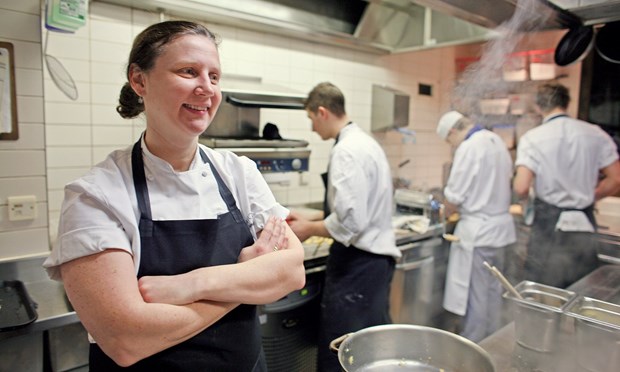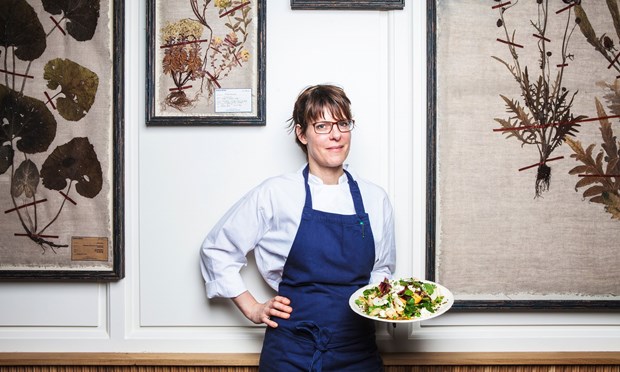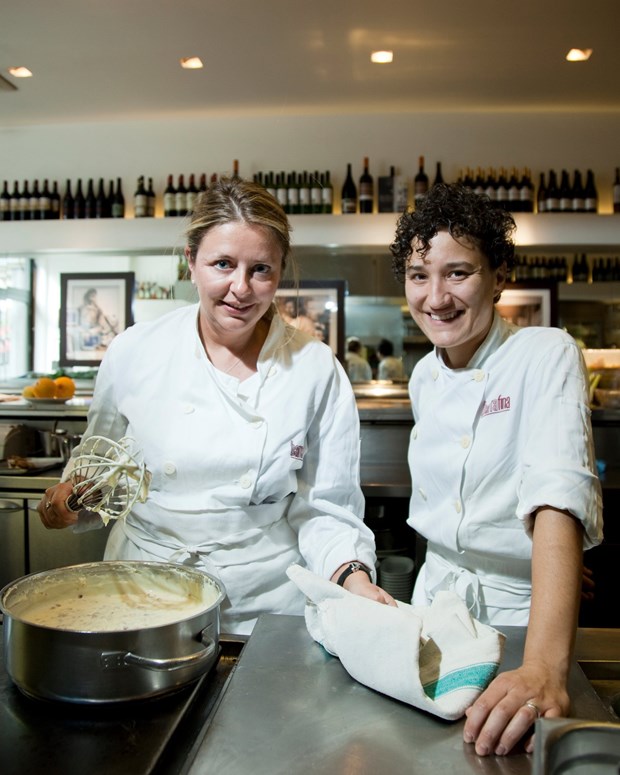Despite huge changes in kitchen culture, fewer than a fifth of professional chefs in the UK are female, down on last year. Is its reputation for being a tough, male-dominated job still putting women off – or is that image unfair?

‘I don’t think catering is the only industry where there are fewer women’, Angela Hartnett. Photograph: Martin Godwin for the Guardian
We’re
a proudly greedy nation and our food fixation seems nowhere near sated, even
with new restaurants mushrooming at a gobsmacking rate. So it’s no shock that
according to the Office of National Statistics, there are 21,000 more
professional chefs in the UK this year than last, a total of 250,000. But what
is unexpected, and unwelcome, is that only 18.5% of them – some 46,000 – are
women, a decrease on the previous year’s percentage of 20.5%. Yep, an actual
decline. It’s surprising when you consider the hospitality industry’s recent
efforts to make itself more, well, hospitable to all. This is a modernising
profession with more employers working to create teams and nurture talent, give
people the time to have relationships outside the kitchen and offer support
within it. That might not be industry-wide yet, but it is on the upswing as a
generational shift slowly takes place. So if things aren’t really that bad,
does the restaurant world have an image problem that is keeping potential
candidates away?
“The
next generation of chefs and restaurateurs aren’t people who left school at 15,
worked as a commis chef in a three [Michelin] star until they’re broken and
then perpetuate the same thing in their kitchens,” says Sabrina Gidda, head
chef of Italian restaurant Bernardi’s. “It’s people who gave up degrees and
business and other things to do what they really love.” She agrees that there’s
too much focus on the reputed hardships rather than the rewards, whatever your
background. “A lot of people all over the world work long hours and, yes, it is
hot and can be tough, but the thrill of being in a busy service with your
entire brigade absolutely nailing it is unlike anything else.” Gidda is mindful
of a distinct lack of diversity and hopes her recent appearance on Saturday
Kitchen might encourage young Asian women to consider a career in cooking.
“Where are the young female Indian chefs who want to come through? It’s highly
regarded to have culinary aptitude in a domestic sense, but to be a senior chef
running a kitchen isn’t. And that’s relevant to me, to make it more
acceptable.”

Anna Hansen. Photograph: Alex Lake/The Observer Magazine
Angela
Hartnett is one of the nation’s very best chefs and joint owner of five
excellent restaurants, three of which have women installed as head chefs. She
points out that hospitality is not isolated in its gender-imbalanced staffing.
“I find it bizarre that it always comes up, as I don’t think catering is the
only industry where there are fewer women. It just seems like everyone hones in
on it. I think it’s great to have a balance of genders and a mix of young and
old too.” She’s also taken aback at the stats, noting the industry’s improving
conditions, support initiatives such as Hospitality Action and more awareness
among employers that staff need looking after. “It’s a no-brainer: create a
great environment where the staff food is good and people want to work
together. Go into your restaurant, chat to your staff, know their names. It
makes a big difference.”
Anna
Hansen, chef-proprietor of two The Modern Pantry restaurants, also employs a
mixed brigade, “I wouldn’t hire a female candidate over a better male candidate
per se, but I definitely make sure that I’ve got lots of females in the
kitchen.” The idea that women might depart to start a family doesn’t daunt her
either. “Everybody has to work and if we want the population to grow then, as
the child-bearers, women are going to have to continue to have to do it.
Everyone is entitled to make a decision and that applies to every career.”
She’s also adamant that fostering an inclusive working environment is the best
way to keep staff in the business. “Girls do get harassed, so you have to be
aware of it. Not that people are inherently negative, but it’s easy to shift a
vibe if you’re constantly pecking away at it.”
Anna
Tobias, head chef at Rochelle Canteen, points out that pieces that discuss
gender, including this one, can further isolate women. “There’s constantly
articles about women and tough jobs, which might make people think: ‘Why are
they getting so upset?’ Also, if men aren’t included, it’s not helpful. All of
the men I work with are incredible feminists.” But, she allows: “Women do need
better rights and to be viewed with more respect. I just hope it’s an inclusive
discussion.”

Rachel Cooke and Nieves Barragan Mohacho at Barrafina. Photograph: Pal Hansen for the Observer
And
it needs to involve more than just the profession, it seems, as sexism can come
courtesy of customers. “Occasionally they will thank my sous chef as they just
assume he’s the head chef. It’s disappointing,” says Tobias. Further proof is
provided by Gidda. “When we opened Bernardi’s, we must have had 10 or 12 tables
over the course of the opening weeks that said: ‘We really love the food, can
we meet the chef as we want to tell him how good it was?’ When I walk up the
stairs, they’re like: ‘OK, that’s not what we were expecting’ and ‘Are you
actually the chef?’ So, it’s not necessarily the industry and the environment,
it’s the guests’ perspectives too.”
Nieves
Barragan Mohacho, executive head chef of the three Barrafina restaurants, also
believes that media representation might be partially responsible for the lack
of women in the profession. “I think a lot of women would want to come into the
kitchens, but I think it has a bad reputation. We need to talk about it more
[positively] because it used to be like hell but not any more. Now it’s fun.”
Like Gidda, Hartnett, Hansen and Tobias, Barragan believes the key to
manifesting a working environment that attracts and retains chefs is treating
them as individuals. “Without them, I’m nothing, so I try to do as much as
possible for them to be happy, such as giving them days off when family comes over
… Also, I don’t stick people in one section only, chefs want to learn. These
things help.”
“I
spent three years with no laundry even in my size,” says Rosy Rong, a rising
head chef who previously worked at St John, John Salt and Moro. “If you’re
looking for a physical indication that this is an environment not made for you,
try wearing clothes that make you feel like you’re playing dress up.” At new
restaurant The Stores Kitchen, Rong is well aware that the industry needs to
work on its representation, conditions and image to achieve a truly diverse
workforce. Rong echoes the thoughts of every chef included in this piece – “I
hate the caveat, female chef. I’m just a chef!”
Hopefully
before too long, this point will no longer need to be made.
Read more: Women's
Day: A day to recall and to honor all female chefs in culinary world
By Suze Olbrich/ The Guardian